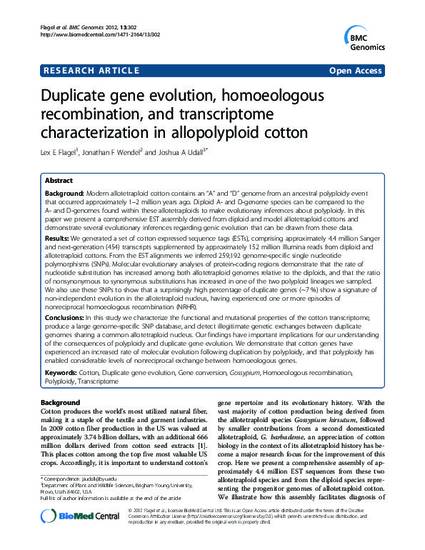
Modern allotetraploid cotton contains an “A” and “D” genome from an ancestral polyploidy event that occurred approximately 1–2 million years ago. Diploid A- and D-genome species can be compared to the A- and D-genomes found within these allotetraploids to make evolutionary inferences about polyploidy. In this paper we present a comprehensive EST assembly derived from diploid and model allotetraploid cottons and demonstrate several evolutionary inferences regarding genic evolution that can be drawn from these data. We generated a set of cotton expressed sequence tags (ESTs), comprising approximately 4.4 million Sanger and next-generation (454) transcripts supplemented by approximately 152 million Illumina reads from diploid and allotetraploid cottons. From the EST alignments we inferred 259,192 genome-specific single nucleotide polymorphisms (SNPs). Molecular evolutionary analyses of protein-coding regions demonstrate that the rate of nucleotide substitution has increased among both allotetraploid genomes relative to the diploids, and that the ratio of nonsynonymous to synonymous substitutions has increased in one of the two polyploid lineages we sampled. We also use these SNPs to show that a surprisingly high percentage of duplicate genes (~7 %) show a signature of non-independent evolution in the allotetraploid nucleus, having experienced one or more episodes of nonreciprocal homoeologous recombination (NRHR). In this study we characterize the functional and mutational properties of the cotton transcriptome, produce a large genome-specific SNP database, and detect illegitimate genetic exchanges between duplicate genomes sharing a common allotetraploid nucleus. Our findings have important implications for our understanding of the consequences of polyploidy and duplicate gene evolution. We demonstrate that cotton genes have experienced an increased rate of molecular evolution following duplication by polyploidy, and that polyploidy has enabled considerable levels of nonreciprocal exchange between homoeologous genes.
Available at: http://works.bepress.com/jonathan_wendel/45/

This article is from BMC Genomics 13 (2012): 302, doi:10.1186/1471-2164-13-302. Posted with permission.